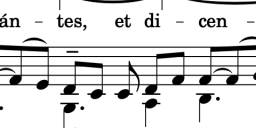Transcription of chant: an observation (and some thoughts on preparing chironomy)
-
In his book on chironomy, Joseph Carroll prefers that the student prepare chironomy with chant transcribed on the modern staff; he thinks that the patterns are best observed this way, and as far as things go, Dom Mocquereau was fine with representing chant as eight or even quarter notes (for some neumes), so there's no problem for those following the Solesmes practice of the time. Now, as Dr. Weaver pointed out, Mocquereau wasn't a fan of accompaniment — which is fascinating since several of the daughter houses of Solesmes have become famous for accompanied chant…
What gets interesting is an almost throwaway remark about the transcription, even that of Solesmes; Carroll believes that the pressus should not be represented by a quarter note with a marcato, as is commonly done in these older transcriptions. It should be tied eighth notes. I think that I agree. The marcato draws out the importance of the pressus for Solesmes-style singing, but it is not really something that the organist particularly, in my opinion, needs to worry about, even if you play the melody, which most of us will want or need to do, most of the time.
The problem with that is that when you have a slur to show the grouping. It can look kind of ugly; you need to get lucky with automatic placement, now that we do this at home on our laptops, or otherwise proofread (if you are transcribing/typesetting freshly in this older style yourself). In this example from Palm Sunday, the tie and the slur are on the bottom and top respectively after adding the harmonization. Phew.
Of course, if you are more semiologically inclined, and even choirs using the ictus can do this, per Mocquereau himself, you will not be fusing the pressus or the oriscus (or for that matter, a bistropha or tristropha), but it is still, perhaps, a point of emphasis.
I should note too that in my own copies of square notation I use a marcato if I want to accent something rather than the generic accent — I don't want to confuse myself with a short decrescendo (because that can happen on just one neume or syllable), which is perhaps exceedingly idiosyncratic. After all, I could write in the word, but the fewer words, the better, IMHO. So I just deal with the fact that a marcato might suggest one thing when I want another…
By the way, the scores from the Institute of Christ the King are delightful for drawing chironomy if that's your thing, because the notes are big with generous spacing, and for the Mass, it's easier to borrow this than redoing this in Gregorio myself). This is where I think that Carroll is simply wrong. Stick to the square notation; you don't have to draw the curve. Suñol did not. He preferred "a." and "t.", but I find that less helpful and somewhat more tedious, though your mileage may vary.
I also know that the preference today is for something closer to academic notation, with no stems whatsoever, but I don't think that the problem is eliminated unless you don't tie the eighth notes, but is the unity then lost? I think so; even if they're not fused, these two notes are still part of the same neume. Perhaps I'm prejudiced, but two notes on the same degree, on the same syllable, in square notation do not look as isolated as they do in modern (contemporary/academic) versions…
 carroll_excerpt.png1146 x 1716 - 571K
carroll_excerpt.png1146 x 1716 - 571K
 pressus_example_transcribed.png714 x 240 - 31K
pressus_example_transcribed.png714 x 240 - 31K
Welcome to the MusicaSacra Forum!
To participate in the discussions on Catholic church music, sign in or register as a forum member, The forum is a project of the Church Music Association of America.
Categories
- All Discussions21,158
- General Music Discussion8,236
- Job Openings204
- Management of Music Programs850
- Choral Matters533
- Church Documents and Rubrics526
- CMAA Notes304
- Events720
- For Newcomers: Read First26
- Sacred Polyphony547
- Hymnody872
- Gregorian Chant: General2,702
- ↳ Graduale Romanum and Liber Usualis368
- ↳ Graduale Simplex60
- ↳ Semiology63
- Vernacular Plainsong696
- Anglican Use and Anglican Chant68
- Organ, Other Instruments and Repertoire435
- New Composition/Works in Progress1,295
- Recordings234
- Music for Hispanic Ministry159
- Music Education: Children211
- Music Education: General222
- News Items245
- Positions Wanted2
- General Discussion: Catholicism740
- Amusements177
- General Discussion1,035
- Opinions119
